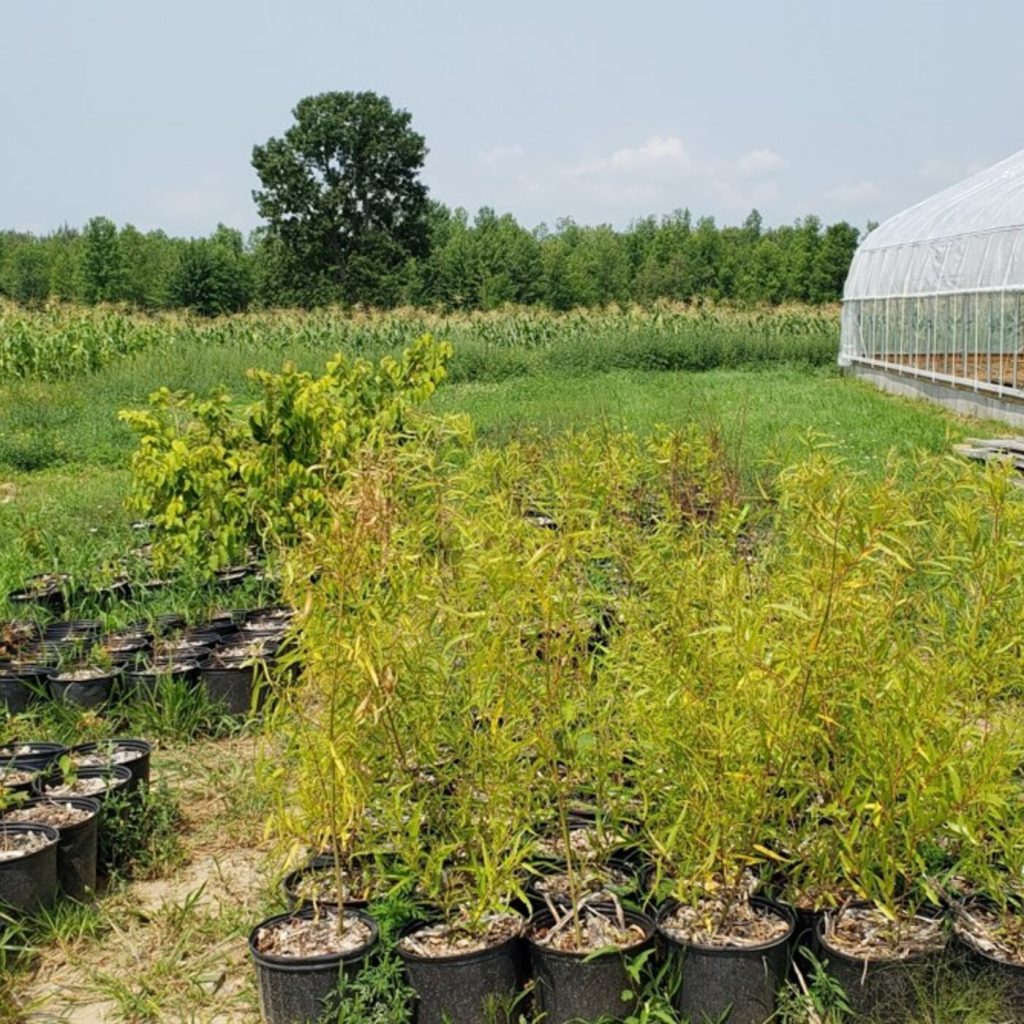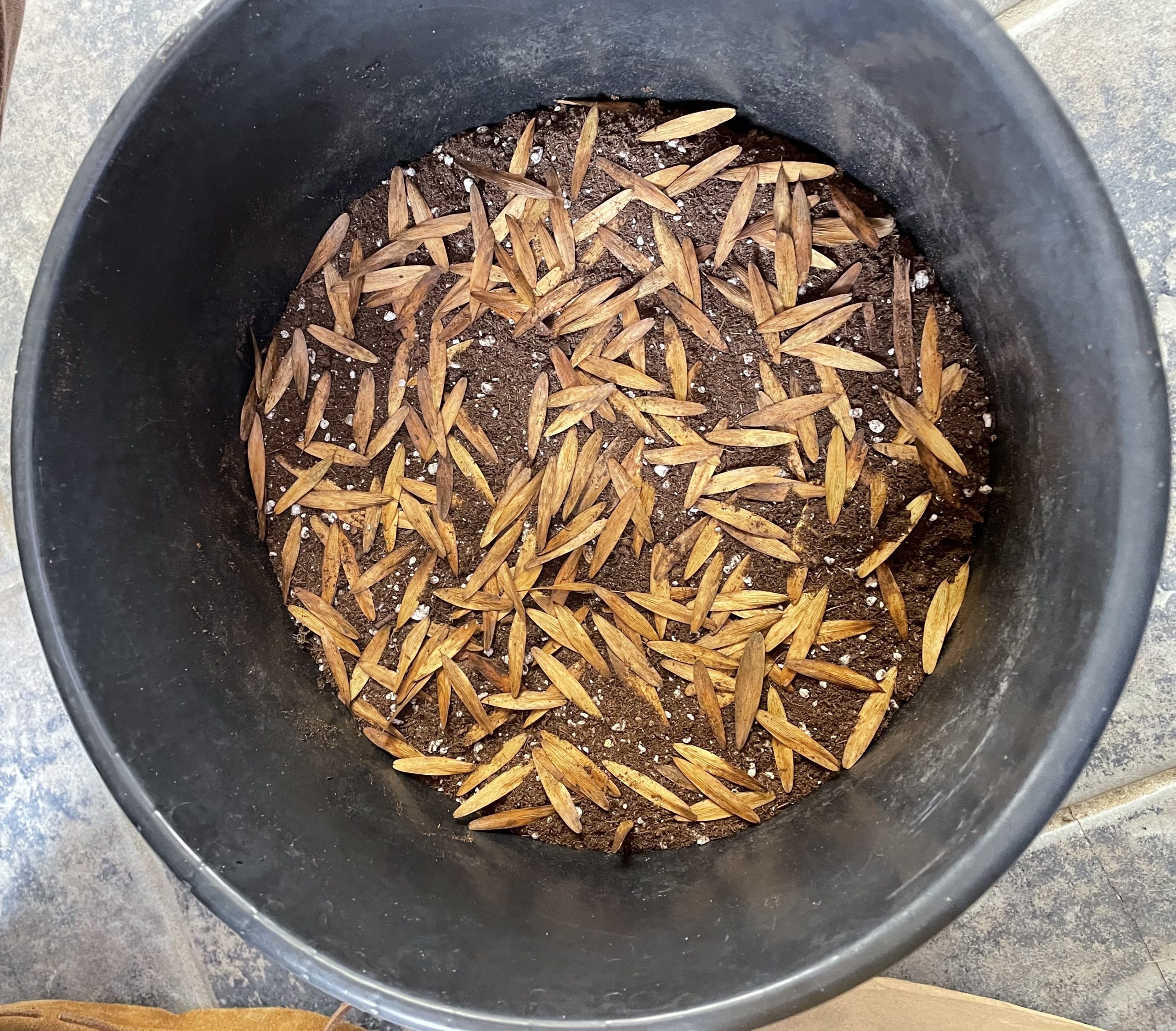Why is it important to collect ash seed?
Seed collection helps create a future for ash on the landscape and for the continuation of Wabanaki cultural practices. Ash seed has multiple uses: it can either be stored in long-term seed banks, or grown out for research, restoration efforts, and Tribal nursery projects. Collectors can decide how they want seed to be used and where to send the seed they collect based on the guidance on this website.
As EAB spreads, it is critical that we collect as much seed as possible in geographically diverse locations. While all three species of ash seed are valuable to collect, collecting brown ash should be prioritized as it has been under-collected in Waponahkik and is currently underrepresented in National genetic research studies and in seed banks. Collected seeds can be used for ongoing research to identify ash trees with partial genetic resistance to EAB, which can be eventually grown out and bred together in long-term progeny studies.
If you’re interested in helping out with ash seed collection, you can email apcaw-group@maine.edu and we can connect you to opportunities in your area.
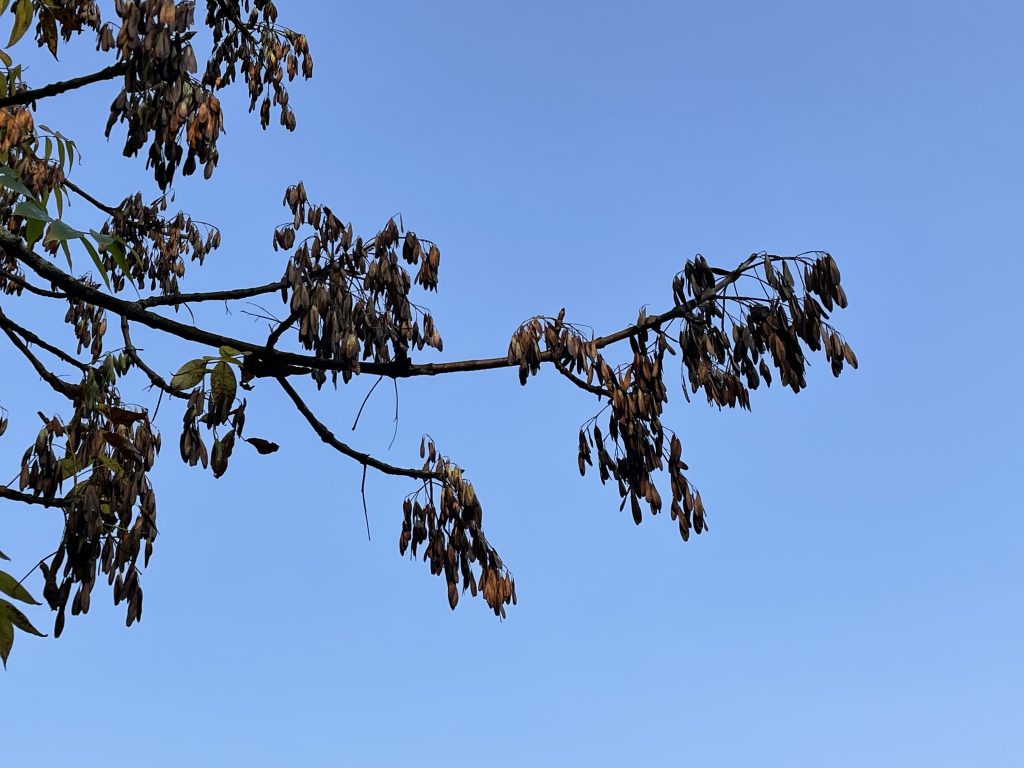
How to collect ash seed
Indigenous artisans called for direction on how to collect brown ash seed, and in turn former APCAW lab member Dr. Emily Francis created the Ash Seed Collection Manual to share step-by-step direction for collecting ash seed. This document and these webpages are meant to be living and updated as new information regarding seed collection, storage, and uses for seed are developed.
When planning for seed collection, collectors should prioritize collection from wild ash (in forest environments) over nursery-stock ash (planted along roadsides or in yards) because wild trees have more genetic diversity. Collectors should also keep in mind that brown ash only produces viable seed every 5-8 years, white ash every 2-3 years, and green ash every year.
Follow the 7 steps below to collect wild ash seed in a forest environment. For more detail about each step consult the Ash Seed Collection Manual.
Brown, green, and white ash grow on a gradient of soil moisture from high to medium. Brown ash is most competitive in areas where it “keeps its feet wet” in wetlands or along streams, while green ash grows in similarly moist soils and also in more upland areas, and white ash in upland sites with mesic (moist) soils. You can use aerial imagery to identify potential ash tree stands within forests: Check out this video made by Colleen Teerling for instruction on how to use Google Earth to find stands.
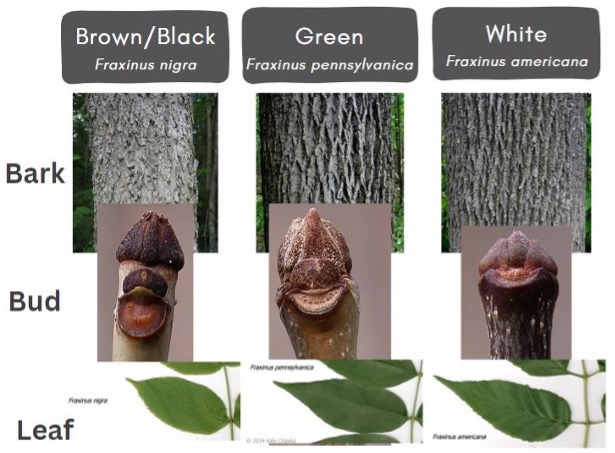
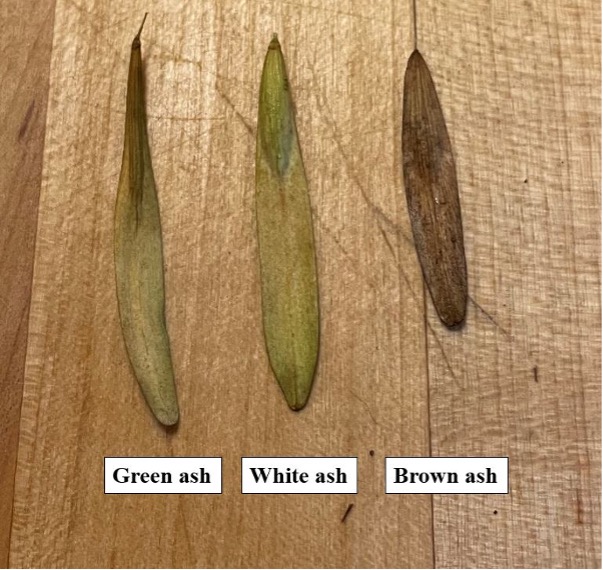
Brown ash trees have three possible sexes: female, male or polygamous, meaning that the tree can produce both female and male flowers. Identifying the sex of a tree is important as only female and polygamous trees can produce seeds. APCAW and Gulf of Maine Research Institute put together this short video to help citizen scientists ID ash flowers. The female trees are often described as wispy or “feathery, yellow panicles, 1 to 2 inches long,” as seen in the picture below. Male flowers are rounded or globular, and dark in color. These can often be seen after spring time and into the summer, but they can be hard to distinguish on particularly tall trees. Remnants of the flowers are sometimes seen throughout the rest of the year from the ground with binoculars. The female flowers leave behind the stems, making them look like long bristles at the end of the tree branches, and male flowers are dark blobs in the same place, but on male trees. Polygamous trees can be difficult to distinguish unless both parts of flowers are left behind. The female and male flowers bloom at different times to prevent self-pollination, and therefore it is possible to mark a tree as one sex and later see it present as another.

Seed collection requires year-round planning. Spring is a good time to inventory and scout for flowering. Seed collecting takes place between August and the first week in October, with the processing and storage immediately after collection. The end of October and to December is time to evaluate the collection cycle, complete records, and share outcomes with partners. Late winter, January to March, can be a time for resupplying and updating protocol for the next round of spring tree scouting, and the whole cycle starts again.
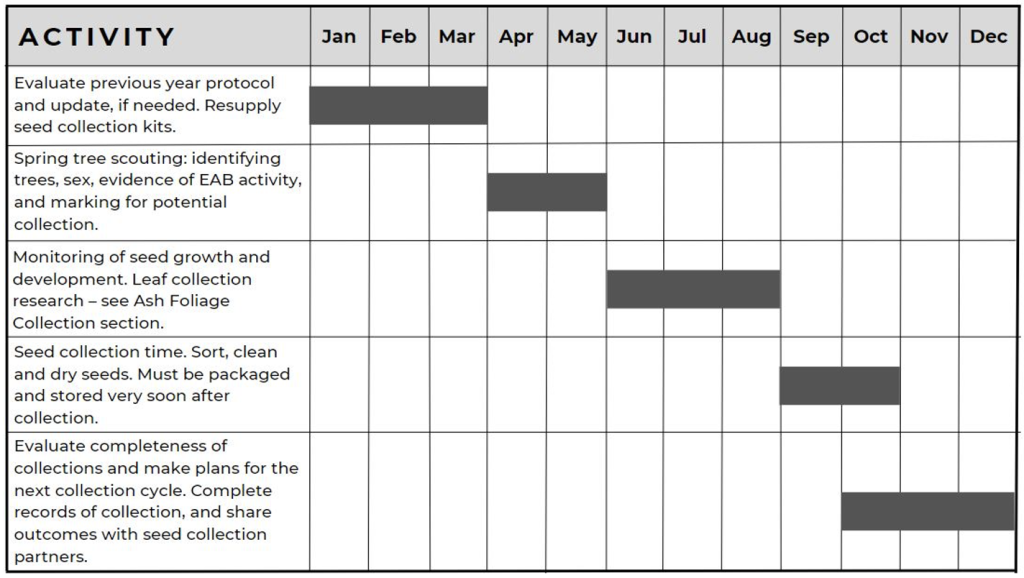
Having the proper items for ash seed scouting and collecting is very important. Brown ash, in particular, can be difficult to access due to the wet areas it prefers, and may not be near roads. The following list of items for seed collection was developed with experts from the St. Regis Mohawk Tribe’s Natural Resources Department, forestry professionals, as well as harvesters, to find what works best for collecting ash seed.
If you would like to request seed collection materials, please reach out to apcaw-group@maine.edu. We have some kits available for check out.

There are 3 different locations we suggest sending processed seed for cold storage. Each facility has different requirements for level of processing, how the seed can be requested and used, and how much seed you collect.
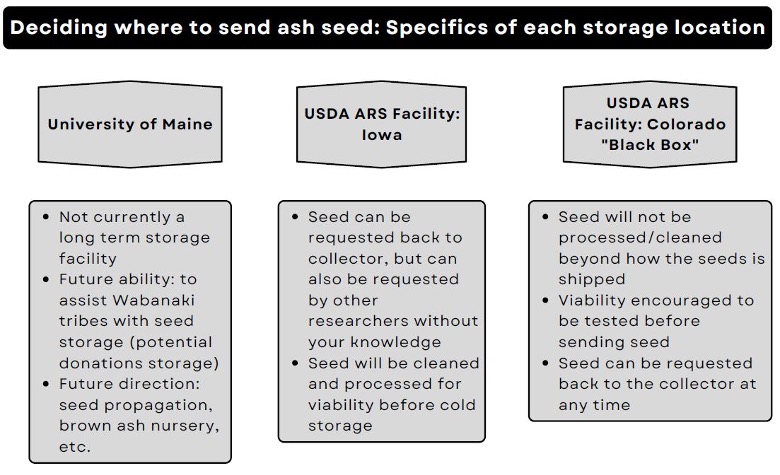
The flowchart below can help you determine which facility is right for your seed.
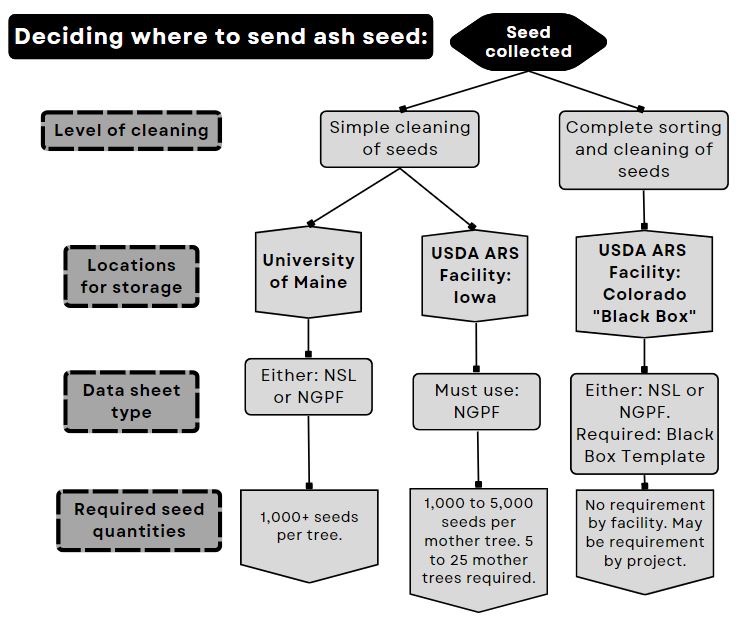
To send seed to any of the locations in this flowchart, you are required to fill out a data sheet to document the location of the trees and site characteristics. There are two different data collection sheets depending on where you plan to send the seed you collect. Please find links to PDFs of the data sheets here:
If you have questions about terminology used in these data sheets, please refer to the appendix of the Ash Seed Collection Manual for a list of definitions.
The methods you use to collect seed will vary according to tree height, branch distance, and surrounding environment. Some ash trees may not be reachable with a pruning pole, or may require more pruning poles than suggested in our seed kit item list. We also recommend using a Notch (TM) Big Shot to collect seed that is not reachable via pruning pole. The Ash Seed Collection Manual has detailed descriptions of different methods of collecting seed, including pole pruning, tarp shaking with a rope and weight, rope saw, or by hand. Or, for a more technical review of methods, check out the USDA Forest Service’s pamphlet, Methods for Collecting Ash Seed.

There are different processing requirements depending on the storage or research facility you are sending seed to.
Simple cleaning
Required for University of Maine and USDA ARS Facility Iowa
Remove seeds from the bag and spread them out on a table or in a cool room. Remove all samaras (shown below) from their twigs, and dispose of any samaras with insect damage or mold, as well as woody debris, like larger sticks, twigs, leaves, grass or anything other than samaras that may have gotten into the bag in the field. Leaving leaves in the bag can increase the moisture content of the samaras while the seeds are being transported. If the samaras are wet, leave them out to dry before putting them back into the paper bags.
Complete sorting and cleaning of seeds
Required for submission to the USDA ARS Colorado “Black Box”
This process prepares seed to go directly into cold storage. The instructions provided for the submission of seed to this facility can be found in the Appendix section of the Ash Seed Collection Manual, titled “Recommendations for the collections, storage, and germination of ash (Fraxinus spp.) seed” (Ellis, 2006). This section outlines sort and test seed for viability before sending to the facility.
As with packaging seeds, each facility that seeds are shipped to has specific criteria for shipping. Ground transportation shipping is recommended, as shipping via airline can affect the moisture content of the seeds. Please see the table below for more details.
Seeds can be brought in person to the University of Maine in person to Nutting Hall and the School of Forest Resources administrative office. Materials must be in paper bags with a completed datasheet stapled to each bag with information about who collected and dropped off the seed, and what level of processing the seed has undergone. Please contact apcaw-group@maine.edu to let the team know you have left seed and to set up an appointment if you are dropping off many bags of seed.

Ash seed collection progress map
We maintain an ongoing record of areas where seed has been collected and EAB is present, in order to identify priority areas for seed collection. If you have collected seed and want to make sure the collection is captured in this map, please email apcaw-group@maine.edu!
View the ArcGIS Online Map here.
Growing ash from seed
Wild ash populations will be significantly affected by EAB. One way to help maintain ash on the landscape is to grow ash from seed and reintroduce these seedlings in an area with suitable conditions. This will create a living seed bank, and help create a future in which Tribal artisans can continue to harvest and use brown ash for basketmaking.
Growing ash in your backyard
Anyone can grow ash seed in their backyard to help this effort. After collecting seed in late Summer, seeds can be sown between November and January. Before sowing, soak ash seeds in cold water overnight. We recommend that you prepare pots with compacted potting soil, and scatter ash seeds over the soil (Figure 1). Next, cover the seeds with a thin layer of sand until they are just barely visible (Figure 2). Brown ash seed is shade intolerant, so situate pots in an area that gets at least some direct sun and remember to label them. We also recommend covering the pots with a thin wire mesh to keep squirrels from digging into the soil and disrupting germination. Ash seeds must go through at least 1, but usually 2, Winter seasons before they break dormancy and germinate, so be prepared to wait!
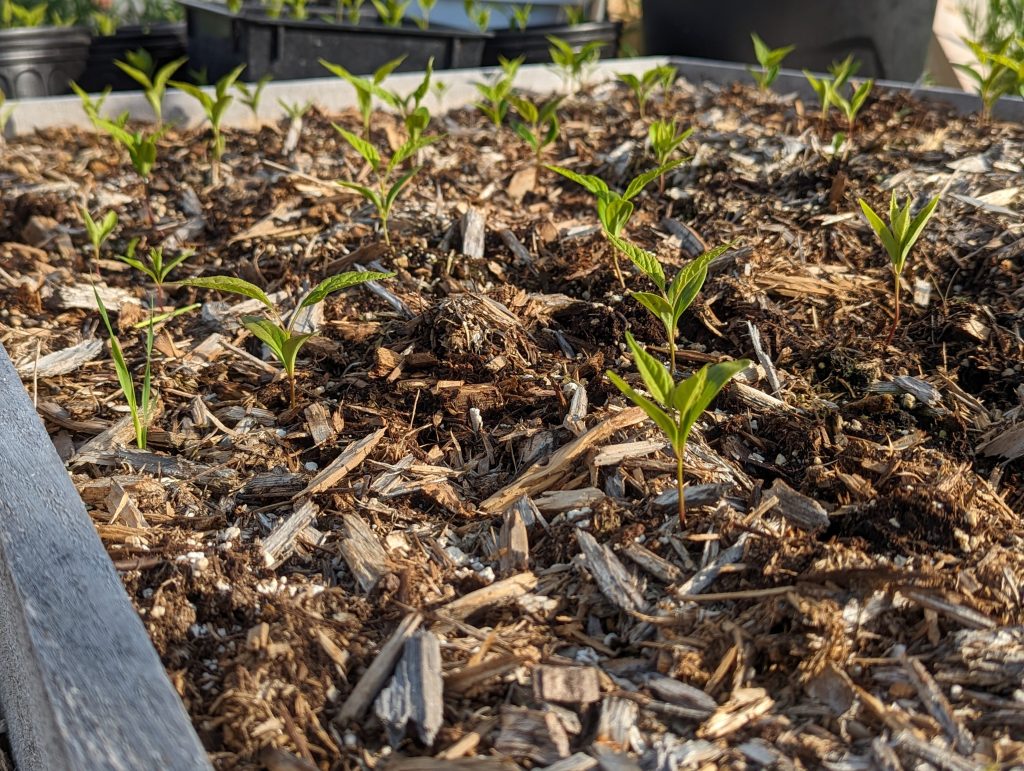
Growing ash in a nursery
In a nursery setting, ash seeds can be germinated more quickly and grown on a larger scale. With technology like deep freezes, seeds can be artificially stratified, or triggered to germinate, at a rate faster than they would under natural circumstances. If you own or work for a nursery and would like to grow ash for forest regeneration, please reach out to apcaw-group@maine.edu
The St. Regis Mohawk Tribe is leading the way in experimenting with growing ash in a nursery setting. In 2004, Les Benedict (Mohawk Akwesasne Tribe) and Richard David developed a protocol for propagating black ash which captures the most effective methods thus far.
Listen to Listen to Jessica Raspitha, Environmental Specialist for the Mohawk Akwesasne, and McKay Burley, employee at the new Akwesasne Native Plant Nursery in St. Regis, New York, discuss the importance of ash regeneration on this episode of the Restoration Roundup podcast.
